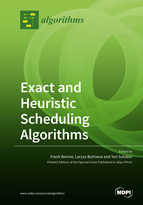Exact and Heuristic Scheduling Algorithms
A special issue of Algorithms (ISSN 1999-4893).
Deadline for manuscript submissions: closed (15 November 2019) | Viewed by 38670
Special Issue Editors
Interests: scheduling, in particular development of exact and approximate algorithms; stability investigations is discrete optimization; scheduling with interval processing times; complexity investigations for scheduling problems; train scheduling; graph theory; logistics; supply chains; packing; simulation and applications
Special Issues, Collections and Topics in MDPI journals
Interests: discrete optimization; scheduling; graph theory; uncertainty
2. Ivannikov Institute for System Programming, RAS Moskow, Alexander Solzhenitsyn Street, 25, 109004 Moskow, Russia
Interests: multi-objective resource optimization; security, uncertainty, dynamic scheduling; adaptive resource allocation
Special Issue Information
Dear colleagues,
We invite you to submit your latest research in the area of the development of scheduling algorithms to this Special Issue, “Exact and Heuristic Scheduling Algorithms”. We are looking for new and innovative approaches for solving scheduling problems exactly or approximately. High-quality papers are solicited to address both theoretical and practical issues of scheduling algorithms. Submissions are welcome both for traditional scheduling problems and new applications. Potential topics include, but are not limited to, single-criterion and multi-criteria scheduling problems with additional constraints such as setup times/costs, precedence constraints, batching/lot sizing, resource constraints, as well as scheduling algorithms for problems arising in emerging applications, such as healthcare, transport, and energy management.
Prof. Dr. Frank Werner
Dr. Larysa Burtseva
Prof. Dr. Yuri Sotskov
Guest Editors
Manuscript Submission Information
Manuscripts should be submitted online at www.mdpi.com by registering and logging in to this website. Once you are registered, click here to go to the submission form. Manuscripts can be submitted until the deadline. All submissions that pass pre-check are peer-reviewed. Accepted papers will be published continuously in the journal (as soon as accepted) and will be listed together on the special issue website. Research articles, review articles as well as short communications are invited. For planned papers, a title and short abstract (about 100 words) can be sent to the Editorial Office for announcement on this website.
Submitted manuscripts should not have been published previously, nor be under consideration for publication elsewhere (except conference proceedings papers). All manuscripts are thoroughly refereed through a single-blind peer-review process. A guide for authors and other relevant information for submission of manuscripts is available on the Instructions for Authors page. Algorithms is an international peer-reviewed open access monthly journal published by MDPI.
Please visit the Instructions for Authors page before submitting a manuscript. The Article Processing Charge (APC) for publication in this open access journal is 1600 CHF (Swiss Francs). Submitted papers should be well formatted and use good English. Authors may use MDPI's English editing service prior to publication or during author revisions.
Keywords
- enumerative scheduling algorithms
- approximate scheduling algorithms
- scheduling heuristics and metaheuristics
- evolutionary algorithms
- complexity of scheduling algorithms
- algorithms for multi-criteria scheduling
- scheduling algorithms for supply chains
- scheduling algorithms for problems in logistics, transport, timetabling, healthcare, engineering, and energy management
- algorithms for resource-constrained project scheduling problems
- just-in-time scheduling
- assembly line balancing and scheduling
- railway scheduling
- agent-based scheduling
- real-time scheduling
- scheduling under uncertainty







